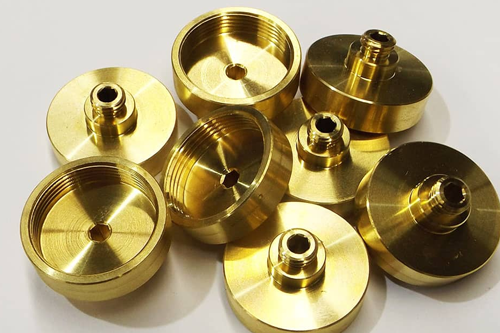brass
- Brass (CNC) is a highly machinable alloy with good tensile strength and natural corrosion resistance. Ideal for parts that require low friction.


About brass Material
Brass is a metal alloy made of a combination of copper and zinc. It has a high machinability factor (better than Stainless Steel), though its raw material cost is slightly higher. However, brass has a high scrap return, which can reduce the cost of raw material.
Think3D offers two Brass alloys: Brass C360 and Brass C260. Both of these alloys come with the higher zinc content. Brass C360 is the most cost-effective metal for machining because of its soft, easily machinable nature and the low impact it has on machining tools. In general, brass is known for its medium hardness and high tensile strength. This makes it suitable for applications in the electrical goods, consumer goods, architecture, automotive, and healthcare sectors.
Quick Overview
| Processes | Lead Time | Grades | Tolerance | Price | Applications |
|---|---|---|---|---|---|
| CNC Machining | As fast as 3 days | C360 & C260 | With drawing: as low as +/- 0.005 mm No drawing: ISO 2768 medium | Qty & Precision dependent | Electronic hardware and contacts, fittings, commercial products, Aerospace |
Design Recommendations
| Services Name | Max Size | Min Size | Min Thickness | Undercuts | Radii Depth |
|---|---|---|---|---|---|
| For CNC Machining | Max Part Size: 600 mm | Min End Mill Size: 0.8 mm | Min Wall Thickness: 0.5 mm | Undercuts: Square profile, full radius, dovetail profiles | Radii: Depth: Depth must not exceed 12x drill bit diameter. For end mills, depth must not exceed 10x tool diameter. |
Frequently Asked Questions
- High Malleability. Copper gives brass its high malleability. …
- Conductivity. Apart from malleability, copper is also the one responsible for brass’s heat and electrical conductivity. …
- Corrosion Resistance. Brass is a non-ferrous or non-iron-containing metal. …
- Antibacterial Property.
These three metals contain little or no iron, and so do not rust, but they can react with oxygen. Brass is an alloy of copper, zinc, and other elements, which also resists corrosion
The primary reason is that it simply takes longer to machine unleaded brass than 360 brass. It also requires different types of cutting tools, presents potential problems for maintaining acceptable surface finish due to chip breakage, and produces chips that may be more difficult to remove.
3D Printers and 3D Printing: Technologies, Processes and Techniques. 3D printing is also called additive manufacturing. This term accurately describes how this technology works to create objects. “Additive” refers to the successive addition of thin layers between 16 to 180 microns or more to create an object.
Currently not available.
Clients

Think3D has been a great partner for us in supplying COVID-19 test cartridges on-time despite the pandemic challenges. When we came up with a new requirement needing a workforce of more than 25 people, think3D took up the challenge and arranged the workforce within 2 days. I highly recommend think3D for any manufacturing needs.
Sanket Srivatsav
Production In-Charge, Molbio

As a professor doing research on new materials, I needed a strong industry partner to assist us. think3D perfectly fit that bill. think3D team is highly knowledgeable on all manufacturing technologies and the team is very prompt in responding to all our requests. My research has been very successful, thanks to think3D team.
Dr. Karthik Chetan V
Asst. Professor, BITS Pilani

We found issue with one part at the time of assembly and needed a quick replacement. think3D team has quickly responded to our request, redesigned the part and printed it using metal 3D Printing and delivered in 3 days time. The part came out really well and the design was better than that of the actual one.
Rama Krishna
Senior Manager (IMM), BDL




























